中国组织工程研究 ›› 2017, Vol. 21 ›› Issue (26): 4106-4112.doi: 10.3969/j.issn.2095-4344.2017.26.002
• 组织工程口腔材料 tissue-engineered oral materials • 上一篇 下一篇
碱性成纤维细胞生长因子/壳聚糖/聚乳酸支架用于牙周组织再生工程的体外实验
陈立红1,雷志敏1,王莉莉2,3
- 1武汉大学人民医院口腔科,湖北省武汉市 430060;2天津市口腔医院修复科,天津市 300000;3锦州医科大学附属口腔医院修复科,辽宁省锦州市 121000
In vitro experimental research of basic fibroblast growth factor/chitosan/polylactic acid scaffolds in periodontal tissue regeneration
Chen Li-hong1, Lei Zhi-min1, Wang Li-li2, 3
- 1Department of Stomatology, Renmin Hospital of Wuhan University, Wuhan 430060, Hubei Province, China; 2Department of Prosthodontics, Tianjin Stomatological Hospital, Tianjin 300000, China; 3Department of Prosthodontics, Stomatological Hospital of Jinzhou Medical University, Jinzhou 121000, Liaoning Province, China
摘要:
文章快速阅读:
.jpg)
文题释义:
碱性成纤维细胞生长因子:属于肝素结合家族,为一种多肽型生长因子,具有广泛的生物学作用,能够促进牙周膜成纤维细胞的有丝分裂和趋化,有利于细胞外基质及牙周膜新生血管网的生成,但其易降解,半衰期短,且生物活性的发挥具有剂量依赖性,单独局部应用代谢迅速。
壳聚糖/聚乳酸复合支架:聚乳酸是人工合成半结晶高分子性物质,溶解性、共混性均较好,但其机械强度不足,脆性亦高,单独应用效果不甚理想;壳聚糖属于碱性多糖,具有良好的生物相容性、生物降解性及机械强度,若将壳聚糖加入聚乳酸中,两种高分子物质相结合,壳聚糖可表现出良好的黏度和韧性,明显改善聚乳酸脆性大、易碎裂的性质。
背景:碱性成纤维细胞生长因子(basic fibroblast growth factor,bFGF)可促进牙周膜成纤维细胞的有丝分裂和趋化,有利于细胞外基质及牙周膜新生血管网的生成,但其易降解、半衰期短,单独局部应用代谢迅速。
目的:探讨bFGF/壳聚糖/聚乳酸复合支架对牙周膜细胞生长和增殖的影响。
方法:采用冷冻干燥法制备不同比例(聚乳酸与壳聚糖的质量比分别为4∶1、3∶2、1∶1、2∶3、1∶4)的壳聚糖/聚乳酸复合支架,以孔隙率、力学强度筛选最优配比的复合支架,用于制备含0,0.1,1,10,100 µg/L bFGF的壳聚糖/聚乳酸支架。①细胞毒性实验:分别以含0,0.1,1,10,100 µg/L bFGF的壳聚糖/聚乳酸支架浸提液(实验组)及DMEM培养液(空白对照组)培养大鼠牙周膜细胞,24,48,72 h后,MTT法检测细胞增殖;培养5 d后,流式细胞仪检测细胞周期;②细胞相容性实验:将含0.1,1,10,100 µg/L bFGF的壳聚糖/聚乳酸支架分别与大鼠牙周膜细胞共培养,1,3,5,7 d后进行细胞计数;培养3 d后,扫描电镜观察细胞生长情况。
结果与结论:①从孔隙率、力学强度指标综合考虑,聚乳酸与壳聚糖的最佳质量比为2∶3;②随着培养时间的延长,各组细胞增殖A值逐渐增加;培养48,72 h时,1,10,100 µg/L实验组细胞增殖A值高于空白对照组(P < 0.05),且10 µg/L实验组细胞增殖A值最高(P < 0.05);③0.1,1,10,100 µg/L实验组G0/G1期细胞百分比低于空白对照组(P < 0.05),以10 µg/L实验组最低;0.1,1,10,100 µg/L实验组S期、G2/M+S期细胞比例均高于空白对照组(P < 0.05),以10 µg/L实验组最高(P < 0.05);④随着培养时间的延长,各组细胞计数逐渐增多;培养3,5 d时,10 µg/L实验组细胞计数高于其余各组(P < 0.05)。培养3 d后,大鼠牙周膜细胞在10 µg/L实验组支架上黏附生长,状态良好;⑤结果表明,bFGF/壳聚糖/聚乳酸复合支架可促进牙周膜细胞的增殖。
中图分类号:
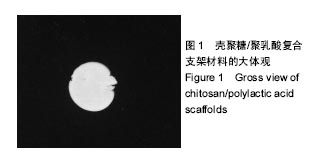
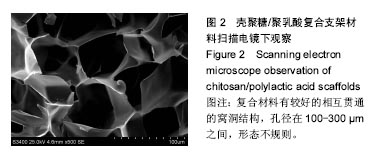
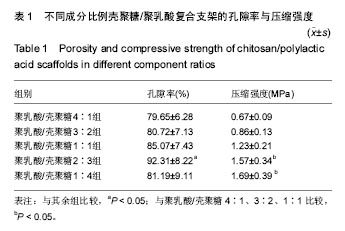

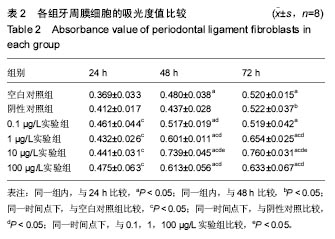

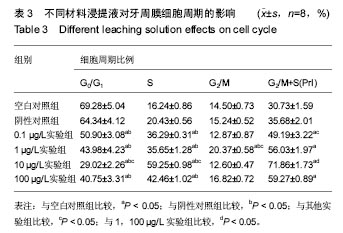

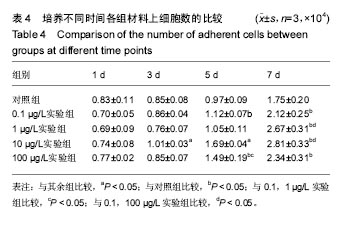
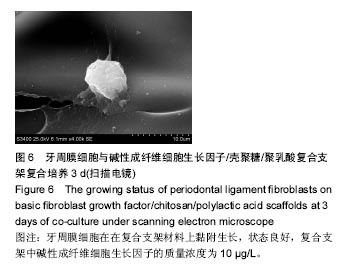
.jpg)
.jpg)